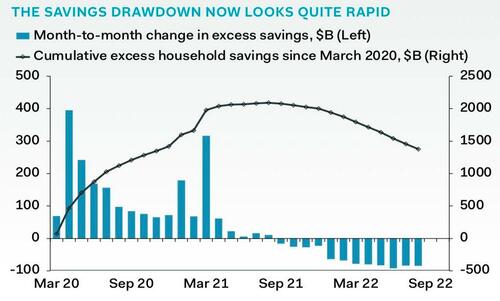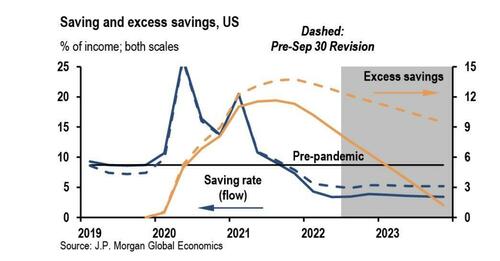Last week, alongside the release of the last revision to Q2 GDP, the Bureau of Economic Analysis also released revisions to national accounts going back several years. They had profound implications for the perceived state of the US economy, and contained some good and some terrible news.
First, the good news: the revision helped to resolve a data conundrum that had been bothering economists - namely the historically large gap between GDP and GDI. As BofA's Michael Gapen explains, GDP was revised modestly higher coming out of the pandemic, while growth in GDI was revised sharply lower. In the debate over whether growth in economic activity slowed markedly in the first half of the year (the prior signal from GDP) or grew modestly (the prior signal from GDI), the latest revisions point in the direction of GDP sending the more accurate signal in real time (yes, it was slowing, contrary to what the Biden admin says).
While that in itself will not resolve the debate whether the US economy was in recession in 1H 22 (it was, but the determination is super political and won't happen ahead of the midterms), it does confirm that momentum slowed appreciably, despite re-opening forces and the rotation of household spending toward services. Bottom line: after revisions, real GDI rose by only 0.8% and 0.1% q/q saar, respectively, in the first and second quarter this year.
The very bad news is that as we expected, the revision confirmed that the US consumer was in worse shape than the data suggested. Far worse shape: That's because the downward revisions to national income were also accompanied by downward revisions to personal income. While personal income was largely unchanged after revisions in 2017 and 2018, it was revised more sharply higher in over the three years ending in 2021, largely on account of non-compensation income sources. That said, after adjusting for inflation and upward revisions to private consumption, the saving rate, measured in percent of personal disposable income was revised consistently lower in 2021. As a result, the saving rate is now reported as ending 2021 at 7.3% versus 7.9% previously.
In 2022, the saving rate was revised even further to 3.4% in 2Q 22 from 5.1% previously. This confirms that contrary to the narrative of 'excess savings', households actually pulled the saving rate lower than previously reported to support spending during a period when inflation was rising rapidly, particularly for nondiscretionary items like food and energy.
In dollar terms, this means that instead of personal savings just shy of $1 trillion (relative to disposable personal income of $18.7 trillion), the dollar value of savings as of August 2022 was actually just $650 billion, a $300 billion drop in savings - and thus wealth - relative to the-prevision number, which of course never existed anywhere besides some (faulty) spreadsheet at the Department of Commerce, and which may have been politically incentivized to show a far higher (and thus healthier) value going into the midterms.
Commenting on this unexpected revision lower, Pantheon Global said that Americans "have run down a much bigger proportion of their pandemic savings than implied by the previous data. The new data show that the peak savings stock was $2.1T, in August last year, and some $630B has been spent, about 31%."
JPM economists also chimed in, writing that "household excess savings amounted to 10-13% of income as of 2Q, but "this took a large hit with last week's US [data] revisions." In other words, not only was the savings buffer of US consumers about 30% lower than "calculated" before, but since this directly Fed into income, with the saving rate now running 5% below its pre-pandemic level, this stockpile will be eaten through by early next year."
Translation: all those Biden stimmies resulting in what economists vowed was over $2 trillion in excess savings and thus stability for the US economy even in a recession scenario, have been largely wiped out, and will be wiped out in just a few months as the chart below shows.
The implication is simple: with the middle class actually far poorer than previously estimated, the next round of stimulus - whether fiscal (good luck with a splite Congress after November) or monetary - can't come fast enough.
via zerohedge





